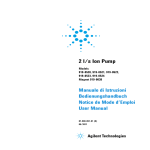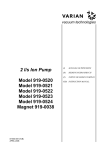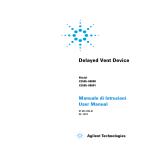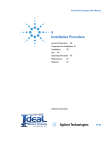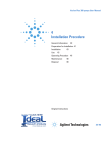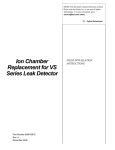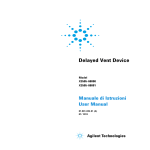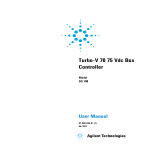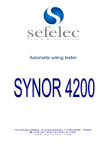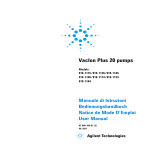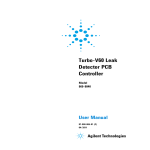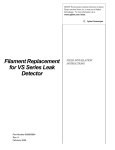Download 4 Instructions for Use - Ideal Vacuum Products, LLC
Transcript
2 l/s Ion Pump User Manual 4 Instructions for Use General Information 32 Preparation for Installation 33 Installation Use 34 36 Operating Procedure Maintenance 38 Disposal 38 37 Original Instructions 31/60 4 Instructions for Use General Information General Information This equipment is destined for use by professionals. The user should read this instruction manual and any other additional information supplied by Agilent before operating the equipment. Agilent will not be held responsible for any events occurring due to non-compliance, even partial, with these instructions, improper use by untrained persons, non-authorized interference with the equipment or any action contrary to that provided for by specific national standards. The 2 l/s series pumps are ion pumps commonly used to create ultrahigh vacuum, due to their cleanliness, ability to pump different gases, and maintenance- and vibration-free operation. The following paragraphs contain all the information necessary to guarantee the safety of the operator when using the equipment. Detailed information is supplied in the appendix "Technical Information". This manual uses the following standard protocol: WARNING! The warning messages are for attracting the attention of the operator to a particular procedure or practice which, if not followed correctly, could lead to serious injury. CAUTION! The caution messages are displayed before procedures which, if not followed, could cause damage to the equipment. NOTE 32/60 The notes contain important information taken from the text. 2 l/s Ion Pump User Manual / 87-900-091-01 (D) 4 Instructions for Use Preparation for Installation Preparation for Installation The pump is supplied in a special protective packing. If this shows signs of damage which may have occurred during transport, contact your local sales office. When unpacking the pump, be sure not to drop it and avoid any kind of sudden impact or shock vibration to it. Do not dispose of the packing materials in an unauthorized manner. The material is 100 % recyclable and complies with EEC Directive 85/399. CAUTION! NOTE In order to prevent outgassing problems, do not use bare hands to handle components which will be exposed to vacuum. Always use gloves or other appropriate protection. Normal exposure to the environment cannot damage the pump. Nevertheless, it is advisable to keep it closed until it is installed in the system, thus preventing any form of pollution by dust. 2 l/s Ion Pump User Manual / 87-900-091-01 (D) 33/60 4 Instructions for Use Installation Figure 1 Installation Do not install or use the pump in an environment exposed to atmospheric agents (rain, snow, ice), dust, aggressive gases, or in explosive environments or those with a high fire risk. During operation, to obtain the declared functioning specification, the ambient temperature must be between 0 °C and +85 °C. CAUTION! 34/60 The pump should be kept sealed until it is ready for attachment to the vacuum system. 2 l/s Ion Pump User Manual / 87-900-091-01 (D) 4 Instructions for Use Installation WARNING! To avoid injury, never connect the high voltage to the pump before it is installed into the system and all the inlet flanges are properly connected or blanked off. NO! The pump operation is optimized using the special Agilent MicroVac controller only. CAUTION! The safety specifications agreement using the pump is guaranteed using the Agilent controller and cable only. CAUTION! The High Voltage cable feedthrough is designed for use with cable Agilent (P/N 929-0706) in conjunction with Agilent MicroVac controller (P/N 929-0200 or 929-0201). Only in this case the “H.V. Cable Safety Interlock” function is available. This function switch off the high voltage when the relevant cable is disconnected from the pump. 2 l/s Ion Pump User Manual / 87-900-091-01 (D) 35/60 4 Instructions for Use Use The pump can be installed in any position. For convenience, a pump is usually mounted vertically with the inlet up, or placed horizontally. Pumps can be supported by the mounting flange in any position. For detailed information about the pump installation, see the appendix “Technical Information”. Use All the instructions for the correct use of the pump are contained in the control unit manual. Read the manual carefully before using the pump. Rough pumping down to 1x10-4 mbar is recommended for the most rapid starting. Roughing with an oil-sealed mechanical pump is not desirable, but when used, a trap in the roughing line is recommended to reduce pressure due to water vapor and oils from the mechanical pump. Be careful to minimize the time that this pump is open to the system and ion pump, since mechanical pump vapors will start diffusing into the system at pressures below 1x10-1 mbar and cause contamination. In systems where oils must be completely eliminated, turbopump roughing pumps should be used. Hygroscopic deposits and hydrogen absorption into titanium may cause starting times to increase with age. During exposure to air, the deposits of titanium compound absorb water vapor. In subsequent start ups, pump heating causes release of the water vapor and some previously pumped hydrogen; thus, the starting time may be lengthened. 36/60 2 l/s Ion Pump User Manual / 87-900-091-01 (D) 4 Instructions for Use Use Operating Procedure Refer to the MicroVac control unit instruction manual and follow the procedure below when operating the pump: WARNING! CAUTION! 1. With a clean roughing pump, establish a roughing pressure of 1x10-4 mbar or lower in the vacuum system. 2. Plug the control unit into a suitable power source and switch the power ON. 3. When the start-up is at a pressure higher than 1x10-4 mbar, MicroVac controller will show an High Load condition. 4. Allow the roughing valve to remain open after turning on the ion pump until an adequate starting pressure is reached. If the ion pump voltage drops after closing the roughing valves, reopen the valve for additional rough pumping. As the pressure decreases, the voltage again will rise, and the roughing valve should be closed. 5. When venting the pump, use dry nitrogen. This will avoid water vapor absorption on the pump walls. When employing the pump for pumping toxic, flammable, or radioactive gases, please follow the required procedures for each gas disposal. Do not use the pump in presence of explosive gases. Do not put any electronic device near the pump otherwise the magnetic field around it may cause a device malfunctioning. 2 l/s Ion Pump User Manual / 87-900-091-01 (D) 37/60 4 Instructions for Use Maintenance Maintenance The 2 l/s series pumps do not require any maintenance. Any work performed on the pump must be carried out by authorized personnel. WARNING! Before carrying out any work on the pump, disconnect it from the High Voltage supply. If a pump is to be scrapped, it must be disposed of in accordance with the specific national standards. Disposal Meaning of the "WEEE" logo found in labels The following symbol is applied in accordance with the EC WEEE (Waste Electrical and Electronic Equipment) Directive. This symbol (valid only in countries of the European Community) indicates that the product it applies to must NOT be disposed of together with ordinary domestic or industrial waste but must be sent to a differentiated waste collection system. The end user is therefore invited to contact the supplier of the device, whether the Parent Company or a retailer, to initiate the collection and disposal process after checking the contractual terms and conditions of sale. 38/60 2 l/s Ion Pump User Manual / 87-900-091-01 (D) 2 l/s Ion Pump User Manual 5 Technical Information Description of the Pump 40 Operating Notes 42 Technical Specification 43 Outline Drawing 45 Installation 48 Pump Assembling 48 Pump Installation 49 Control Unit Connection Bakeout 50 51 Unusual Operating Conditions 51 Pump Troubleshooting 53 2 l/s Pump Replacement Parts and Accessories 54 Original Instructions 39/60 5 Technical Information Description of the Pump Description of the Pump The Agilent VacIon 2 l/s pumps are ion pumps and are available in the following versions: Tab. 1 NOTE PART NUMBER MODEL 919-0520 2 l/s pump mini CFF 919-0521 2 l/s pump ¾” O.D. 180 ° SST tube 919-0522 2 l/s pump 3/8” O.D. 180 ° copper tube 919-0523 2 l/s pump ¾” O.D. 180 ° SST tube vacuum proc. 919-0524 2 l/s pump¾” O.D. 90 ° SST tube tee style The part numbers in the table are relevant to the pump without the magnet. The magnet part numbers is 919-0038. The 2 l/s pump is a pump which operates on the principle of ion gettering in the pressure range from 10-4 to less than 10-9 mbar. A roughing pump is needed to lower the system pressure from atmosphere to below 10-4 mbar. 40/60 Figure 2 Model 919-0520 Figure 3 Model 919-0521 2 l/s Ion Pump User Manual / 87-900-091-01 (D) Technical Information Description of the Pump Figure 4 Model 919-0522 Figure 5 Model 919-0523 Figure 6 Model 919-0524 Figure 7 Magnet model 919-0038 Figure 8 Pump main assemblies 2 l/s Ion Pump / 87-900-091-01 (D) 5 41/60 5 Technical Information Operating Notes Operating Notes VacIon pumps operate as a single-cell Penning discharge. A potential of about 3 kV is applied to the anode cell; the cathodes are at ground potential. Electrons are constrained from going directly to the anode by the presence of an axial magnetic field of about 1200 gauss. A selfshielding insulator isolates the anode from ground potential. When the VacIon pump is operating properly (with magnet installed), the current drawn is proportional to pressure (see the figure in the following page). After the system is rough-pumped to below 10-4 mbar, the pump can be started by simply switching on the VacIon pump control unit. A current draw on the control unit will indicate that the pump discharge has started. The pump can operate in any position and can be supported on the mounting flange. NOTE 42/60 Always wait at least 30 seconds after turning off the high voltage switch before disconnecting the power supply leads. This should allow the power supply output capacitor to discharge adequately. 2 l/s Ion Pump User Manual / 87-900-091-01 (D) 5 Technical Information Technical Specification Technical Specification The following table details the main technical specifications of the 2 l/s Ion Pump. Tab. 2 Nominal pumping speed for Nitrogen (l/s) 2 Operating life at 5x10-6 mbar (hours) 8000 Operating voltage +3300 Vdc +/- 10 % Maximum starting pressure (mbar) 1x10-4 Ultimate pressure (mbar) 10-9 Internal volume (litres) 0.064 Maximum baking temperature (°C) 400 (without magnet) 150 (with magnet) Material: Body Cathode Anode Magnet AISI 304 Titanium AISI 304 Sm-Co Weight, (kg) 0.3 net 0.6 with magnet 2 l/s Ion Pump / 87-900-091-01 (D) 43/60 5 Technical Information Technical Specification Figure 9 44/60 Pressure vs Current curve 2 l/s Ion Pump User Manual / 87-900-091-01 (D) 5 Technical Information Outline Drawing Outline Drawing The following figure shows the outline drawing for the 2 l/s pump and the magnet (all dimensions are in inches [mm]). Figure 10 Model 919-0520 Figure 11 Model 919-0521 2 l/s Ion Pump / 87-900-091-01 (D) 45/60 5 Technical Information Outline Drawing 46/60 Figure 12 Model 919-0522 Figure 13 Model 919-0523 2 l/s Ion Pump User Manual / 87-900-091-01 (D) Technical Information Outline Drawing Figure 14 Model 919-0524 Figure 15 Magnet model 919-0038 2 l/s Ion Pump / 87-900-091-01 (D) 5 47/60 5 Technical Information Installation Installation Pump Assembling Before installing the pump into the system, the pump must be assembled. To assemble the pump, proceed as follows (see the following figure): 1. Remove the pump parts from the packaging. 2. Remove the fixing clip (3) from the magnet (2). 3. Insert the pump (1) into the magnet. 4. Fix the pump to the magnet by means of the fixing clip. Figure 16 48/60 Pump assembly 2 l/s Ion Pump User Manual / 87-900-091-01 (D) 5 Technical Information Pump Installation Pump Installation To install the pump into the system proceed as follows: 1. During installation, keep the pump and system clean. Avoid touching surfaces which will ultimately be under vacuum. When the VacIon pump is open to the atmosphere, take care to avoid introducing foreign particles, oil, solder flux, or any volatile substances. Before attaching the pump, clean the system thoroughly. Chemical cleaning is the most complete cleaning method for the vacuum system; however, do not attempt it when pockets and crevices exist that will prevent thorough rinsing. Degreasing with an acetone or methanol followed by waterrinsing is usually sufficient. 2. To achieve maximum pumping speed, connect the pump to the system with a tube that has the shortest length and the largest diameter possible. 3. For ultrahigh vacuum work, joints should be tungsten inert gas welded, hydrogen brazed, or vacuum brazed. Do not use flux in making joints for ultrahigh vacuum. 4. Gaskets in the system should be of soft metal such as annealed copper, aluminum, or gold. 5. After the pump is sealed in place, leak-check the entire system. 6. Assemble the magnet to the pump. 2 l/s Ion Pump / 87-900-091-01 (D) 49/60 5 Technical Information Control Unit Connection Control Unit Connection WARNING! The high voltage present in the high voltage cable which connects the control unit to the ion pump, can cause severe injury or death. Before mounting the high voltage connector of the cable on the pump high voltage feedthrough, or before removing it, be sure the main power is removed from the control unit. WARNING! To avoid injury, never connect the high voltage to the pump before it is installed into the system and all the inlet flanges are properly connected or blanked off. Make sure that the pump is well connected to the grounded vacuum system. Connect the control unit to the ion pump with the coaxial high voltage cable assembly as follows: WARNING! 50/60 1. Push the female end of the cable connector over the high voltage feedthrough. 2. Push the male end of the cable connector into the socket on the control unit rear panel. (Refer to the control unit instruction manual). Before removing the high voltage connector of the cable from the control unit, be sure the main power is removed from the control unit. Wait at least 10 seconds after removing the main power from the control unit, to allow capacitors to discharge completely. 2 l/s Ion Pump User Manual / 87-900-091-01 (D) 5 Technical Information Bakeout To disconnect the coaxial high voltage cable from the controller, slide the safety locking sleeve (very little sleeve travel is required) from the control unit and at the same time pull on the male end of the cable connector to remove it from the socket on the control unit. Bakeout When a 2 l/s ion pump does not reach the desired base pressure, and there are no leaks, it is necessary to bake the system. This can be done by heating the pump and all the components in the system, and is generally required to achieve less than 10-8 mbar base pressures. The pump body can be baked up to 400 °C if the magnet and the H.V. cable connector have been removed. If the bakeout is done with magnets and H.V. cable connected, the maximum allowable temperature is 150 °C and the pump control unit can be left on in order to be able to monitor the pressure variations. During the bakeout cycle the pressure must not increase above 5x10-5 mbar, if this value is reached, turn the bakeout off and then on again when low pressure is restored. Bake the 2 l/s pump for 24 hours. Longer bakeout periods are recommended when the pump has been used with heavy gas load applications. Wait until the pump cools down to room temperature and recovers its initial pressure before using it in the application. Unusual Operating Conditions If the pump current reads lower than normal for the pressure, the discharge may have been extinguished. To check for the pump being "out of strike" (discharge extinguished), remove the magnet and observe the residual current. If the current is the same with and without the magnet in place, no discharge exists in the pump. 2 l/s Ion Pump / 87-900-091-01 (D) 51/60 5 Technical Information Bakeout 52/60 1. To restart the discharge, tap the pump body with a penny held between the thumb and forefinger, or heat the pump body locally with a small soldering iron. This should liberate surface gas within the pump and restart the discharge. NEVER strike the pump with hand tools. 2. If the magnet strength is below its rated level, the pump discharge and speed will be reduced and the discharge may extinguish at a pressure below 1 x 10-7 mbar. 2 l/s Ion Pump User Manual / 87-900-091-01 (D) 5 Technical Information Pump Troubleshooting Pump Troubleshooting In the event of a power failure (momentary or long period) the controller is switched off. When power is restored, the controller will automatically restart. Tab. 3 SYMPTOM POSSIBLE CAUSE CORRECTION PROCEDURE 1. Slow starting (more than 30 minutes). Air leaks which limit pressure to above 10-6 mbar and cause longer starting time. Leak check the vacuum system with a helium leak detector. 2. Slow pump-down due to absorption of vapours on pump and system walls. Vapours and gases admitted to a system are absorbed on the walls of the system and pump. Subsequent reduction in pressure depends on the rate of depletion of this vapour. Heavy hydrocarbons are most troublesome because of their relative low vapour pressure and are very difficult to remove, even by baking. Heat the system walls, thereby accelerating the desorption process. Baking mobilizes the vapours so they can be cracked and pumped by discharge. 3. Slow starting or slow pump-down. Current higher than expected at any given pressure. High voltage feedthrough is leaking. Replace the feedthrough. Ion pump leakage current causing higher pressure reading. Highpot the pump. 4. 2 l/s Ion Pump / 87-900-091-01 (D) 53/60 5 Technical Information 2 l/s Pump Replacement Parts and Accessories 2 l/s Pump Replacement Parts and Accessories Tab. 4 PART NUMBER 9190520 Basic pump 9190521 Magnet Samarium-Cobalt 919-0522 919-0523 919-0524 919-0038 CABLES HV Bakeable cable, radiation resistant, 13' (4 m) long with safety interlock 929-0706 For a complete overview of Agilent's extensive vacuum product line, please refer to the Agilent Vacuum Catalogue. 54/60 2 l/s Ion Pump User Manual / 87-900-091-01 (D) Request for Return Form Sales and Service Offices United States Agilent Technologies Vacuum Products Division 121 Hartwell Avenue Lexington, MA 02421 - USA Tel.: +1 781 861 7200 Fax: +1 781 860 5437 Toll-Free: +1 800 882 7426 India Agilent Technologies India Pvt. Ltd. Vacuum Product Division G01. Prime corporate Park, 230/231, Sahar Road, Opp. Blue Dart Centre, Andheri (East), Mumbai – 400 099.India Tel: +91 22 30648287/8200 Fax: +91 22 30648250 Toll Free: 1800 113037 Italy Agilent Technologies Italia S.p.A. Vacuum Products Division Via F.lli Varian 54 10040 Leini, (Torino) - Italy Tel.: +39 011 997 9111 Fax: +39 011 997 9350 Toll-Free: 00 800 234 234 00 Southeast Asia Agilent Technologies Sales Sdn Bhd Vacuum Products Division Unit 201, Level 2 uptown 2, 2 Jalan SS21/37, Damansara Uptown 47400 Petaling Jaya, Selangor, Malaysia Tel : +603 7712 6106 Fax: +603 6733 8121 Taiwan Agilent Technologies Taiwan Limited Vacuum Products Division (3F) 20 Kao-Shuang Rd., Pin-Chen City, 324 Taoyuan Hsien , Taiwan, R.O.C. Tel. +886 34959281 Toll Free: 0800 051 342 Canada Central coordination through: Agilent Technologies Vacuum Products Division 121 Hartwell Avenue Lexington, MA 02421 - USA Tel.: +1 781 861 7200 Fax: +1 781 860 5437 Toll-Free: +1 800 882 7426 Japan Agilent Technologies Japan, Ltd. Vacuum Products Division 8th Floor Sumitomo Shibaura Building 4-16-36 Shibaura Minato-ku Tokyo 108-0023 - Japan Tel.: +81 3 5232 1253 Fax: +81 3 5232 1710 Toll-Free: 0120 655 040 UK and Ireland Agilent Technologies UK, Ltd. Vacuum Products Division 6 Mead Road Oxford Industrial Park Yarnton, Oxford OX5 1QU – UK Tel.: +44 (0) 1865 291570 Fax: +44 (0) 1865 291571 Toll free: 00 800 234 234 00 China Agilent Technologies (China) Co. Ltd Vacuum Products Division No.3, Wang Jing Bei Lu, Chao Yang District, Beijing, 100102 China Tel.: +86 (10) 6439 7718 Toll-Free: 800 820 6556 France Agilent Technologies France Vacuum Products Division 7 Avenue des Tropiques Z.A. de Courtaboeuf - B.P. 12 91941 Les Ulis cedex - France Tel.: +33 (0) 1 69 86 38 84 Fax: +33 (0) 1 69 86 29 88 Toll free: 00 800 234 234 00 Germany and Austria Agilent Technologies Vacuum Products Division Alsfelder Strasse 6 Postfach 11 14 35 64289 Darmstadt – Germany Tel.: +49 (0) 6151 703 353 Fax: +49 (0) 6151 703 302 Toll free: 00 800 234 234 00 Korea Agilent Technologies Korea, Ltd. Vacuum Products Division Shinsa 2nd Bldg. 2F 966-5 Daechi-dong Kangnam-gu, Seoul Korea 135-280 Tel.: +82 2 3452 2452 Fax: +82 2 3452 2451 Toll-Free: 080 222 2452 Mexico Agilent Technologies Vacuum Products Division Concepcion Beistegui No 109 Col Del Valle C.P. 03100 – Mexico, D.F. Tel.: +52 5 523 9465 Fax: +52 5 523 9472 Other Countries Agilent Technologies Italia S.p.A. Vacuum Products Division Via F.lli Varian 54 10040 Leini, (Torino) Italy Tel.: +39 011 997 9111 Fax: +39 011 997 9350 Toll-Free: 00 800 234 234 00 Benelux Agilent Technologies Netherlands B.V. Vacuum Products Division Herculesweg 8 4338 PL Middelburg The Netherlands Tel.: +31 118 671570 Fax: +31 118 671569 Toll-Free: 00 800 234 234 00 Singapore Agilent Technologies Singapore Pte. Ltd, Vacuum Products Division Agilent Technologies Building, 1 Yishun Avenue 7, Singapore 768923 Tel : (65) 6215 8045 Fax : (65) 6754 0574 © Agilent Technologies, Inc. 2011 Printed in ITALY 05/2011 Publication Number: 87-900-091-01 (D) Customer Support & Service NORTH AMERICA: Toll Free: 800 882 7426, Option 3 [email protected] EUROPE: Toll Free: 00 800 234 234 00 [email protected] PACIFIC RIM: please visit our website for individual office information http://www.agilent.com Worldwide Web Site, Catalog and Order On-line: www.agilent.com Representative in most countries 12/10






























